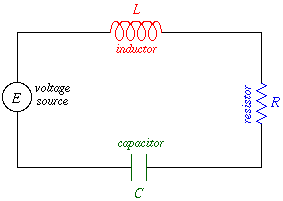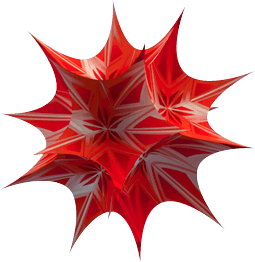Initial Value Problem Applications - Electric Circuits
Applications of Differential Equations
Electric Circuits
A Theoretical Introduction
As you probably already know, electric circuits can consist of a wide variety of complex components. These may be set up in series, or in parallel, or even as combinations of both. In this laboratory, however, we'll be considering only series circuits with especially simple components: resistors, inductors, and capacitors, along with some form of voltage supply.
The mathematics required to deal with such circuits goes a little beyond your high-school physics usage of Ohm's Law. After all, in these circuits the quantities of interest may be changing, and change implies that rates of change may get involved. It looks like once again we will be seeing equations involving derivatives—differential equations.
To start with, let's consider the picture of a simple series circuit in which one of each of the components that we mentioned above appears:
In this diagram we see each of the components that we just mentioned. The labels have the following meanings:
- L is a constant representing inductance, and is measured in henrys
- R is a constant representing resistance, and is measured in ohms
- C is a constant representing capacitance, and is measured in farads
- E represents the electromotive force, and is measured in volts. It is not necessarily a constant, and may be a function of time
Although they don't appear in the diagram, there are a few other quantities that will be involved in our analysis:
- q represents charge, and is measured in coulombs
- I represents current, and is measured in amperes
- t represents time, and is measured in seconds
So how do we start to find the relationships over time between these quantities? The key is to use Kirchoff's second law, which states:
The sum of the voltage drops across each component in a circuit is equal to the voltage, E, impressed upon the circuit.
Obviously then, in order to make use of this statement, we need to know what the voltage drop across each component is. Physics has the answer for us! Let's go through the components one at a time:
- the inductor: produces a voltage drop of L dI/dt, or LI′.
- the resistor: produces a voltage drop of RI.
- the capacitor: produces a voltage drop of q/C.
Restating Kirchoff's second law in abbreviated form, we get the following:
sum of the voltage drops = E,
which may be restated as:
inductor voltage drop + resistor voltage drop + capacitor voltage drop = E,
into which we may substitute the actual voltage drops that we mentioned above, to get:
| (1) | LI′ + RI + q/C = E. |
But, also according to physics, I = q′, so substituting, we can rewrite the equation purely in terms of the charge, q, rather than a mixture of charge and current:
| (2) | Lq″ + Rq′ + q/C = E, |
or alternatively, if we differentiate equation (1) and use the same substitution, we get an equation purely in terms of current:
| (3) | L I″ + R I′ + I/C = E′. |
We will be mainly concerned with using the last of these three equivalent forms.
Notice that equation (3) is linear with constant coefficients, so in the case when
E′ = 0, (the homogeneous case), it may be solved very easily, even by hand.
The form of E′ will determine the method necessary when solving the non-homogeneous case by hand. We would need to use either undetermined coefficients, or variation of parameters. (Fortunately, in this laboratory we'll be letting the computer do the work for us.)
We're now going investigate the application of this model to various circuits, paying special interest to the graphs of our solutions, i.e. the graphs of current against time. Let's now go and see how we would deal with this type of problem using Mathematica.









